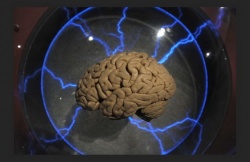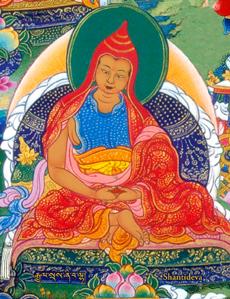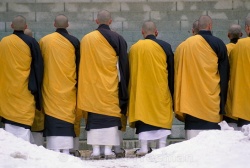Bodhicitta
[[Image:Avalokiteshvara.JPG|thumb|Avalokiteshvara)
Bodhichitta(Skt. bodhicitta; Tib. བྱང་ཆུབ་ཀྱི་སེམས་, chang chub kyi sem; Wyl. byang chub kyi sems) is the compassionate wish to attain enlightenment for the benefit of all beings.
Nature
Buddhist scholars have debated whether bodhichitta is to be categorized as the 'main mind' (Tib. གཙོ་སེམས་, tso sem; Wyl. gtso sems) or a 'mental state' (Tib. སེམས་བྱུང་, sem jung; Wyl. sems byung). Asanga and Vasubandhu were among those claiming it is a mental state, while Arya Vimuktasena and Haribhadra believe that it is the main mind. In his Light on the 25,000 Verses (Tib. ཉི་ཁྲིད་སྣང་བ་, nyi khrid snang ba), Arya Vimuktasena specifies that it is the mental consciousness (Tib. ཡིད་ཀྱི་རྣམ་ཤེས་, yid kyi rnam shes).
The supreme good heart is bodhichitta. ‘Bodhi’ is the Sanskrit word for ‘enlightenment’, and ‘chitta’ the word for ‘mind’; therefore ‘bodhichitta’ literally means ‘mind of enlightenment’.
It is defined as a mind, motivated by compassion for all living beings, that spontaneously seeks enlightenment.
Bodhichitta is born from great compassion, which itself depends upon cherishing love.
Cherishing love can be likened to a field, compassion to the seeds, taking and giving to the supreme methods for making the seeds grow, and bodhichitta to the harvest.
The cherishing love that is developed through the practice of exchanging self with others is more profound than that developed through other methods, and so the resultant compassion and bodhichitta are also more profound.
Without great compassion, the spontaneous wish to protect all living beings from suffering, bodhichitta cannot arise in our mind; but if we have great compassion, especially the great compassion generated through exchanging self with others, bodhichitta will arise naturally. The strength of our bodhichitta depends entirely upon the strength of our great compassion.
Of all Dharma realizations, bodhichitta is supreme. This profoundly compassionate mind is the very essence of the Bodhisattva’s training. Developing the good heart of bodhichitta enables us to perfect all our virtues, solve all our problems, fulfill all our wishes, and develop the power to help others in the most appropriate and beneficial ways.
Bodhichitta is the best friend we can have and the highest quality we can develop. We generally consider someone who is kind to his or her friends, takes care of his parents, and gives freely to worthwhile causes to be a good person; but how much more praiseworthy is a person who has dedicated his or her whole life to relieving the suffering of each and every sentient being?
Atisha had many Teachers, but the one he revered above all was Guru Serlingpa. Whenever he heard Serlingpa’s name, he would prostrate. When Atisha’s disciples asked him why he respected Serlingpa more than his other Teachers, he replied, ‘It is due to the kindness of Guru Serlingpa that I have been able to develop the good heart of bodhichitta.’ Through the power of his bodhichitta, Atisha was able to bring great joy and happiness to everyone he met, and whatever he did was of benefit to others.
Definition
[[Image:Arya Vimuktisena.JPG|thumb|Arya Vimuktisena)]
Literal Meaning/Etymology
Bodhi means our ‘enlightened essence’ and chitta (Skt. citta) means ‘heart’ or 'mind', hence the translation ‘the heart of enlightened mind’.
Scholarly Definitions
The most famous definition of bodhichitta appears in Maitreya's Abhisamayalankara:
|
This has twin aspects or purposes:
1) focusing on sentient beings with compassion, and
2) focusing on complete enlightenment with wisdom.
Khenpo Pema Vajra defines bodhichitta as "the wish to attain enlightenment in order to free all other sentient beings from the sufferings of existence and lead them to the unsurpassable bliss of omniscience."[2]
Khenpo Tsöndrü defines the generation of bodhichitta as "a special type of mental consciousness endowed with two aspects, inspired by the cause, longing to bring about the welfare of others, and accompanied by the support, longing to attain complete and perfect awakening."[3]
Divisions
Absolute & Relative
Bodhichitta is categorized into ‘relative’ or ‘conventional bodhichitta’, and ‘absolute bodhichitta’.
- Relative bodhichitta entails the compassionate wish to attain enlightenment for the benefit of all living beings and to train in the methods to achieve that aim.
- Absolute bodhichitta is the direct insight into the absolute nature of things.
Aspiration & Action
Within relative bodhichitta there is also the distinction between ‘bodhichitta in aspiration’ and ‘bodhichitta in action’, which is portrayed by Shantideva as the difference between deciding to go somewhere and actually making the journey:
|
|
The Three Types of Commitment
- the king's way of arousing bodhichitta, with the great wish
- the boatman's way of arousing bodhichitta, with sacred wisdom
- the shepherd's way of arousing bodhichitta, beyond compare
Four Types of Bodhichitta According to the Paths and Levels
Bodhichitta can also be divided according to the five paths and ten bhumis:
- bodhichitta of aspiring conduct (Tib. མོས་པས་སྤྱོད་པའི་སེམས་བསྐྱེད་, Wyl. mos pas spyod pa'i sems bskyed ) (path of accumulation onwards)
- bodhichitta of pure noble intention (Tib. ལྷག་བསམ་རྣམ་དག་གི་སེམས་བསྐྱེད་, Wyl. lhag bsam rnam dag gi sems bskyed) (first bhumi onwards)
- bodhichitta of full maturation (Tib. རྣམ་པར་སྨིན་པའི་སེམས་བསྐྱེད་, Wyl. rnam par smin pa'i sems bskyed ) (eighth bhumi onwards)
- bodhichitta free from all obscurations (Tib. སྒྲིབ་པ་སྤངས་པའི་སེམས་བསྐྱེད་, Wyl. sgrib pa spangs pa'i sems bskyed ) (at the level of buddhahood)
There is also a division into twenty-two similes of bodhichitta, and the Sagaramatiparipriccha Sutra (Tib. བློ་གྲོས་རྒྱ་མཚོས་ཞུས་པའི་མདོ་, Wyl. blo gros rgya mtshos zhus pa'i mdo) mentions a classification according to eighty inexhaustibles which are discussed in Mipham Rinpoche's Khenjuk.
The Actual Training in Bodhichitta
[[Image:Patrul Rinpoche.JPG|thumb|left|Patrul Rinpoche courtesy of Shechen Monastery)]
Patrul Rinpoche says[5] that the training in bodhichitta has three elements:
- training in the cause by meditating on the four immeasurables,
- the actual training, which is to practise taking the vow of bodhichitta three times during the day and three times at night,
- and the training in the precepts, the meditations on equalizing and exchanging yourself and others, and consider others as more important than yourself.
The actual training in bodhichitta is to take the vow of bodhichitta by means of any formal practice—whether elaborate, medium or short—at the six times of the day and night, i.e., at dawn, mid-morning, midday, afternoon, dusk and midnight.
- 'Equalizing self and others’ means recognizing the equality of yourself and others in wishing to find happiness and wishing to avoid suffering.
- ‘Exchanging self and others’ means giving your own happiness to other sentient beings, and taking their suffering upon yourself.
- ‘Considering others as more important than yourself’ means setting aside your own benefit and accomplishing the benefit of others.
If you apply yourself to these practices, Patrul Rinpoche says, then you will never forget the mind of bodhichitta in all your future lives, and all the qualities of the bhumis and paths will develop and increase like the waxing moon.
Bodhichitta in Dzogchen
In a Dzogchen context, especially in the teachings of the category of mind, bodhichitta is used to refer to the awakened mind, or rigpa. In Chapter 12 of the Treasury of the Dharmadhatu[6], Longchenpa explains the literal meaning of bodhichitta in Dzogchen:
|
|
This is his commentary[7] on the verse:
|
|
Footnotes
- ↑ {{:Quotations: Maitreya, [[Ornament of Clear Realization, Definition of bodhichitta}}
- ↑ ༈ གཞན་སེམས་ཅན་ཐམས་ཅད་སྲིད་པའི་སྡུག་བསྔལ་ལས་བསྒྲལ་ཏེ་ཐམས་ཅད་མཁྱེན་པའི་བདེ་བ་བླ་ན་མེད་པ་ལ་འཇོག་པའི་དོན་གྱི་ཆེད་དུ་བྱང་ཆུབ་ཐོབ་པར་འདོད་པ།, gzhan sems can thams cad srid pa'i sdug bsngal las bsgral te thams cad mkhyen pa'i bde ba bla na med pa la 'jog pa'i don gyi ched du byang chub thob par 'dod pa from Notes on Bodhichitta to Illuminate the Path of the Victorious One's Heirs.
- ↑ The Words of Jikmé Chökyi Wangpo: A Commentary Presenting the Subject Matter of the Great Treatise, the Abhisamayalankara
- ↑ Bodhicharyavatara, I, 15 & 16
- ↑ Translation on Lotsawahouse: [http://www.lotsawahouse.org/tibetan-masters/patrul-rinpoche/essential-instruction-refuge-bodhichitta Patrul Rinpoche: Essential Refuge and Bodhichitta]
- ↑ see the Seven Treasuries
- ↑ Longchen Rabjam: A Treasure Trove of Scriptural Transmission (Skt. Dharmadhātu ratna koṣa nāma vṛtti; Tib. ཆོས་དབྱིངས་རིན་པོ་ཆེའི་མཛོད་ཅེས་བྱ་བའི་འགྲེལ་པ།, Wyl. chos dbyings rin po che'i mdzod ces bya ba'i 'grel pa), see the entry for Treasury of Dharmadhatu.
Further Reading
- Khunu Rinpoche, Vast as the Heavens, Deep as the Sea: Verses in Praise of Bodhicitta, Wisdom Pub., 1999.
- The Light of Wisdom, Volume 1. Root text by Padmasambhava and commentary by Jamgön Kongtrül the Great. Published by Shambhala Publications ISBN 0-87773-566-2, Chapters 12, 13 & 14, pages 115-155.
External Links
Source
In Buddhism, bodhicitta (Sanskr. बोधिचित्त, Ch. 菩提心, putixin, Jp. bodaishin, Tibetan བྱང་ཆུབ་ཀྱི་སེམས་,Wyl. byang chub kyi sems jang chub sem, Mongolian бодь сэтгэл), "Enlightenment-mind", is the mind that strives toward awakening and compassion with all Sentient beings.
Etymology
Etymologically, the word is a combination of the Sanskrit words Bodhi and Citta. Bodhi means "awakening" or "Enlightenment". Citta is derived from the Sanskrit root cit, and denotes "that which is conscious" – mind or consciousness. Bodhicitta may be translated as "awakening mind" or "mind of Enlightenment".
Definition
Bodhicitta is the intention to achieve omniscient Buddhahood (Trikaya) as fast as possible, so that one may benefit infinite Sentient beings. One who has bodhicitta as the primary motivation for all of his or her activities is called a Bodhisattva.
Bodhicitta is the union of compassion and Wisdom. This is a development of the concept of Luminous mind in the Pali Canon.
Bodhicitta also means the aim to, on the one hand, bring happiness to all Sentient beings, and on the other, to relieve them of Suffering.
The term bodhicitta in its most complete sense would combine both:
- the arising of spontaneous and limitless compassion for all Sentient beings, and
- the falling away of the attachment to the illusion of an inherently existent self.
Levels of bodhicitta
A distinction can be made between relative and absolute bodhicitta:
- Relative bodhicitta refers to a state of mind in which the practitioner works for the good of all beings as if it were his own.
- Absolute, or ultimate, bodhicitta, refers to the Wisdom of Shunyata (śunyatā, a Sanskrit term often translated as "emptiness", though the alternatives "openness" or "spaciousness" probably convey the idea better to Westerners). The concept of śunyatā in Buddhist thought does not refer to nothingness, but to freedom from attachments and from fixed ideas about the world and how it should be.
Some bodhicitta practices emphasize the absolute (e.g. vipaśyanā), while others emphasize the relative (e.g. Metta), but both aspects are seen in all Mahāyāna practice as essential to Enlightenment, especially in the Tibetan practices of Tonglen and Lojong. Without the absolute, the relative can degenerate into pity and sentimentality, whereas the absolute without the relative can lead to nihilism and lack of desire to engage other Sentient beings for their benefit.
Patrul Rinpoche states that there are different levels of bodhicitta:
- The lowest level is the way of the King, who primarily seeks his own benefit but who recognizes that his benefit depends crucially on that of his kingdom and his subjects.
- The middle level is the path of the boatman, who ferries his passengers across the river and simultaneously, of course, ferries himself as well.
- The highest level is that of the shepherd, who makes sure that all his sheep arrive safely ahead of him and places their welfare above his own.
Although classification systems do vary (some schools even denying any conceptualizing of the path to Buddhahood) e.g. yellow hats argue that with bodhicitta one enters the path of accumulation
Origins and development
Luminous mind and bodhicitta
Luminous mind (also, "brightly shining mind," "brightly shining Citta") is a term used by the Buddha in the Pali Canon. It is described as the most fundamental aspect of the mind, and is said to be "brightly shining" whether or not this is realized. It is given no direct doctrinal interpretation in the Pali discourses; one way the Mahāyanā interprets it is as bodhicitta. The Astasahasrika Perfection of Wisdom Sūtra describes bodhicitta thus:
- That Citta is no Citta since it is by nature brightly shining.'
This is in accord with Anguttara Nikaya I,10 which goes from a reference to brightly shining Citta to saying that even the slightest development of Loving-kindness is of great benefit. This implies that Loving-kindness - and the related state of compassion - is inherent within the Luminous mind as a basis for its further development. The observation that the ground state of consciousness is of the nature of Loving-kindness implies that empathy is innate to consciousness and exists prior to the emergence of all active mental processes. Source Texts
Among the most important source texts on Bodhichitta, within the Mahāyāna tradition in which the teaching arose, are:
- Śāntideva's A Guide to the Bodhisattva's Way Of Life (c. 700 CE),
- Thogme Zangpo's Thirty-Seven Practices of a Bodhisattva (12th century CE),
- Langri Tangpa's Eight Verses for Training the Mind (c. 1100 CE), and
- the Lojong (mind training) proverbs authored by Geshe Chekhawa in the 12th century CE.
Practice
Mahayana Buddhism propagates the Bodhisattva-ideal, in which the Six perfections are being practiced. Arousing bodhicitta is part of this Bodhisattva-ideal.
Bodhisattva ideal
In Mahāyāna and Vajrayāna Buddhism, the goal of Buddhist practice is primarily to be reborn infinite numbers of times to liberate all those other beings still trapped in samsāra.
Paramitas
Mahāyāna Buddhism teaches that the broader motivation of achieving one's own Enlightenment "in order to help all Sentient beings" is the best possible motivation one can have for any action, whether it be working in one's vocation, teaching others, or even making an incense offering. The Six Perfections (Pāramitās) of Buddhism only become true "perfections" when they are done with the motivation of bodhicitta. Thus, the action of giving (Skt. Dāna) can be done in a mundane sense, or it can be a Pāramitā if it is conjoined with bodhicitta. Bodhicitta is the primary positive factor to be cultivated.
Cultivation
The Mahāyāna-tradition provides specific methods for the intentional cultivation of both absolute and relative bodhicitta. This cultivation is considered to be one of the most difficult aspects of the path to complete awakening. Practitioners of the Mahāyāna make it their primary goal to develop a genuine, uncontrived bodhicitta which remains within their mindstreams continuously without having to rely on conscious effort.
Among the many methods for developing uncontrived Bodhicitta given in Mahāyāna teachings are:
- Contemplation of the Four immeasurables (Brahmaviharas):
- Immeasurable Loving-kindness (Maitri),
- Immeasurable Compassion (Karunā),
- Immeasurable Joy in the Good Fortune of Others (Mudita), and
- Immeasurable Equanimity (Upeksa)
- The practice of the Pāramitās (Generosity, Patience, Virtue, Effort, Meditation, and Insight).
- The Taking and Sending (Tonglen) practice, in which one takes in the pain and Suffering of others on the in-breath and sends them love, joy, and healing on the out-breath, and the Lojong ('Mind Training') practices of which Tonglen forms a part.
- Viewing all other Sentient beings as having been our mothers in infinite past lives, and feeling gratitude for the many occasions on which they have taken care of us.
Universal bodhicitta
The practice and realization of bodhicitta are independent of sectarian considerations, since they are fundamentally a part of the human experience. Bodhisattvas are not only recognized in the Theravāda school of Buddhism, but in all other religious traditions and among those of no formal religious tradition. The present Fourteenth Dalai Lama, for instance, regarded Mother Teresa as one of the greatest modern bodhisattvas.
Source
bodhichitta ( pu-ti-xin): It is the cause that will inevitably lead to enlightenment. It is all the mahayana dharma and the actual practice of that dharma based on vows of great compassion that help living beings become Buddhas and Bodhisattvas. It is the mind of love in the holy sense that both holy (enlightened) and ordinary beings have. One of the eight fundamental right views of cultivation. There are two types: holy bodhichitta and worldly bodhichitta, but both are guided by the two sets of seven branches of bodhichitta. One’s attainment in the Buddha-dharma depends upon one’s level of bodhichitta. Literally the mind of enlightenment. The term “arouse bodhichitta” has several levels of meaning. For the unenlightened, it is a determination to become enlightened in order to liberate all living beings from samsara. However, in a deeper sense, bodhichitta means the enlightened mind, Buddha-nature, non-dual wisdom, or primal awareness. In the broadest sense it is ultimate truth.
See Also



